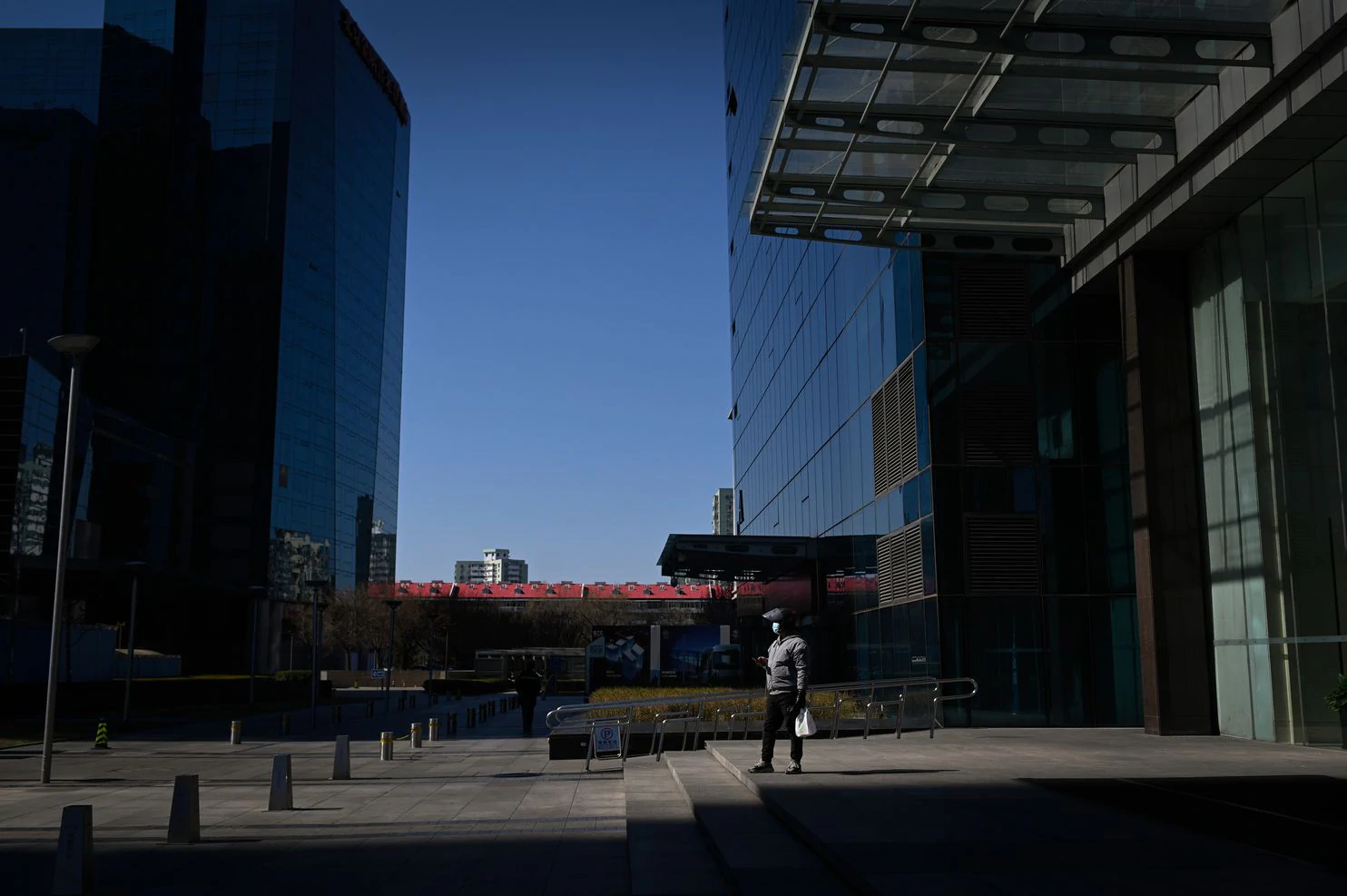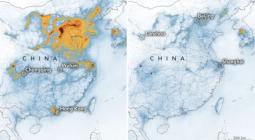Coronavirus could halt the world’s emissions growth. Not that we should feel good about that..
Emissions are already way down in China, the world’s largest yearly contributor to climate change
Humans have seemed unable to get a handle on climate change, with global emissions of greenhouse gases continuing to grow every year. But a microscopic pathogen, so structurally simple that it does not even have a single cell and is arguably not even alive, may be capable of accomplishing what our political leaders thus far cannot.
Experts say that greenhouse gas emissions in China, the world’s largest current contributor to climate change, are down 25 percent in recent weeks as the country conducted a massive societal intervention to stop the spread of the virus. Air pollution is also down, due to decreased driving and less coal burning.
Meanwhile, as the virus enters a second phase, spreading beyond China to other countries, it is dampening global demand for oil and air travel, and threatening overall global economic growth. All of these are strongly linked to greenhouse gas emissions.
While it’s too early to say for sure, if these trends continue, the coronavirus could join rare company. Since the year 1900, greenhouse gas emissions have risen dramatically. During that period, the escalation of emissions has been nearly constant, with 2019 projected to set yet another record high. And when significant declines have happened, it’s usually been because of world wars, sweeping economic contractions or large-scale geopolitical events such as the fall of the Soviet Union.
When it comes to an emissions decline, "whatever the driver, it will have to be big, and global,” said Glen Peters, an expert on carbon emissions at Norway’s Center for International Climate Research and a contributor to the Global Carbon Project.
The last time global emissions fell noticeably was in the wake of the Great Recession, from 2008 to 2009 — when U.S. GDP fell 4.3 percent, unemployment doubled from 5 to 10 percent, housing prices crashed and the stock market lost, at the nadir, more than half of its value.
But even in that moment of economic and societal trauma, the global emissions decline was fleeting. Emissions started to rise again almost immediately.
Still, if the current emissions contraction that happened first in China spreads around the world, and is sustained, then it might cause a similar impact.
Elizabeth Economy, a China expert at the Council on Foreign Relations, said the nation’s emissions have increased every year for the past three until coronavirus paralyzed entire regions.
“If there is a bright side to the coronavirus," she said, "it is that the drop in industrial production, manufacturing, and automobile use will produce a noticeable drop in CO2 emissions for at least the first two months of the year.”
Granted, the bounce back could be rapid if China tries to juice its economy through some type of stimulus once the situation stabilizes. South Korea has already enacted roughly $10 billion in stimulus in the wake of the virus’s spread, and Italy is planning an infusion of $8.4 billion.
“The reductions are substantial, but they are most certainly only temporary, and there will likely be a rebound effect,” said Joanna Lewis, an expert on China’s energy sector at Georgetown University. “Once people go back to work and factories restart, they may try to make up for lost time. This could result in a surge in emissions.”
Still, the change since the start of the year in the world’s most greenhouse-gas-intensive economy has been striking to behold.

Lauri Myllyvirta, lead analyst at the Center for Research on Energy and Clean Air, found that carbon emissions in China are down at least a quarter over the month of February. He estimates it amounts to a reduction of 200 million tons of carbon dioxide compared with emissions levels in 2019.
A combination of satellite images shows vehicles at a toll plaza before the coronavirus crisis in Wuhan, China, in October 2019 (top), and the empty toll plaza during the coronavirus outbreak in February 2020. (Maxar Technologies/Reuters)
Concentrations of nitrogen dioxide, or NO2 — which are produced by cars, trucks and energy-intensive industries — are down about 40 percent during the same stretch, he found. In addition, small-particle air pollution also has fallen across the country.
Myllyvirta said that while emissions have rebounded a bit over the past week, “it’s still very far from normal levels.”
“Oil demand and demand for things like coal and steel have fallen,” he said. “The impact on many of the major industrial sectors is very profound.”
He said sales of real estate are likely to fall sharply over the first quarter of the year in China. The outbreak will impact construction projects and investment decisions for months to come, all factors that could hinder economic growth and slow emissions.
The effects seen in China may ripple around the world.
The International Air Transport Association recently announced that global January air travel, while still showing growth, saw “the lowest monthly increase since April 2010.” And February’s figures could be even worse.
United Airlines recently announced plans to cut domestic flights by 10 percent and international ones by 20 percent for April and May. It’s asking staff to volunteer for unpaid leaves to help adjust for the decline in revenue.
Aircraft account for roughly 3 percent of total U.S. greenhouse gas emissions, so changes here could have a major impact.
“I expect where the coronavirus is going to be hitting is one of the more energy intensive aspects of the economy, which is travel,” said Kenneth Gillingham, a professor of economics at Yale University.
“I do expect emissions to decline,” Gillingham added. “Not that I think that that is a particularly good thing in this context, because the coronavirus is an absolute tragedy.”

Meanwhile, OPEC and the International Energy Agency both recently lowered their forecasts for oil demand in 2020, thanks to coronavirus. On Thursday, OPEC proposed cutting production by an additional 1.5 million barrels a day through the end of the year, which would be the biggest cut since the 2008 financial crisis.
The OECD, meanwhile, said that in a scenario of broad global spread of the virus, economic growth could only tally 1.5 percent in 2020, as opposed to a prior prediction of 3 percent before the outbreak occurred.
That itself is revealing, though, notes Peters from Norway’s Center for International Climate Research.
“If global growth goes from 3% to 1.5%, then it is very low by historical standards, but nowhere near as low as negative growth from the financial crisis,” Peters said in an email.
From 2008 to 2009, during that seismic economic event, global emissions declined about 1.4 percent, according to figures from Peters and the Global Carbon Project. That’s equivalent to a reduction of about 450 million tons of carbon dioxide.
But then growth quickly resumed, and 2018′s global emissions, nine years after that downturn in 2009, were 16 percent higher. That’s equivalent to an additional 5 billion tons of CO2 per year.
The Global Carbon Project’s data show even larger temporary declines, on a percentage basis, in the past during moments of global upheaval.
Take the Great Depression — the longest-lasting and most severe economic decline affecting the United States and the world since 1900. U.S. unemployment climbed as high as 25 percent and thousands of banks failed. Global emissions, which were then far lower, dropped 25 percent from 1929 to 1932, and did not exceed their 1929 levels again until 1937.
There’s also evidence of an emissions decline from 1918 to 1919, in the wake of thedeadly Spanish Flu, the worst pandemic of the modern world — 50 million people around the globe died. At least initially, this looks like a clear case of a biological event, rather than an economic, political, or military one, driving down emissions — which shrank by more than 400 million tons of carbon dioxide in just one year.
However, that period came in the immediate wake of World War I, and it isn’t clear that the decline was solely due to the pandemic. Emissions also fell as combatants laid down arms, explained Robbie Andrew, also a researcher at Norway’s Center for International Climate Research. Peace also brought an end to wartime spending and a contraction of the emission-intensive steel and arms industries.
“The years immediately after WWI are likely to show a combination of effects that overlapped,” he said in an email.
Other episodes of emissions declining, or flattening, underscore that thus far in history, it has generally required a massive societal or economic upheaval for such a decline to occur.

In October 1973, OPEC retaliated against the United States for its role in the Arab-Israeli war, imposing an oil embargo. The oil cartel slashed production, quadrupling crude prices, fueling inflation broadly, squeezing consumers and throwing the world into recession through 1974. It was then the deepest of four year-long downturns since the mid-1940s. And greenhouse gas emissions declined slightly for a few years.
In 1978, another “oil shock,” this time stemming from the Iranian Revolution and the drop in its oil output, badly hurt the global economy at the worst possible time. In the face of soaring inflation and the falling value of the dollar, the Federal Reserve slammed on the brakes, raising interest rates as high as 19 percent in 1981. Inflation eased by the end of 1982. At the time, it was the most severe recession since the Great Depression. Emissions declined for three years and did not exceed their 1979 levels until six years later, in 1985.
In the early 1990s, the world economy suffered from a U.S. slowdown and the collapse of the Soviet Union — leading, once again, to a modest and temporary emissions decline.
Myllyvirta said the parallels to past episodes when the world has seen its emissions fall are limited. A pandemic, after all, is hardly a humane, desirable or logical way to count on combating climate change.
“To reduce emission in a sustained way, you need the world to run in a clean way — and forever,” he said. “You can’t just lock everyone in their homes and say you shouldn’t go to work.”
“A complete switch from coal to low-carbon generation — or a modest carbon pricing policy — can provide emissions reduction on the same order of magnitude as a war, recession, or a pandemic,”Gillingham added. “This provides at least a sliver of a reason for optimism.”
Steven Mufson contributed to this report.
5 March 2020
The Washington Post




